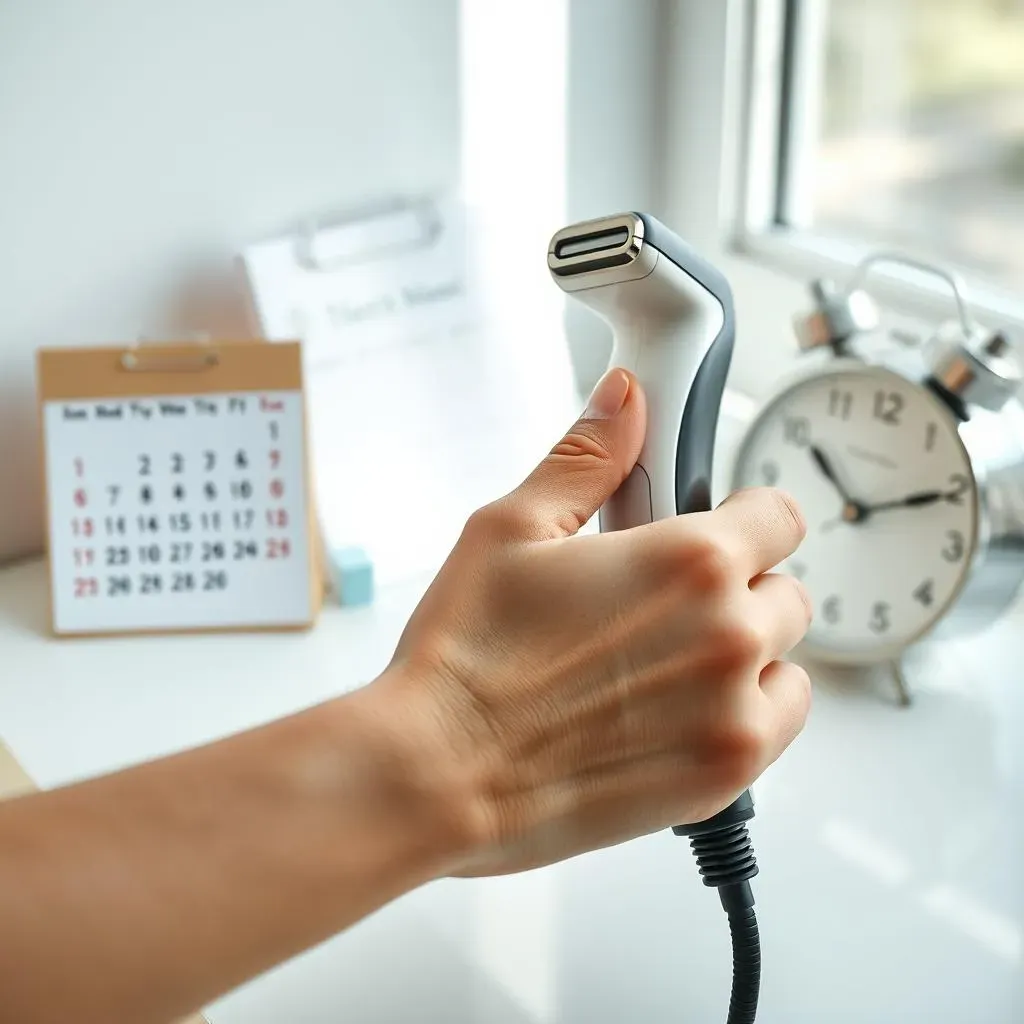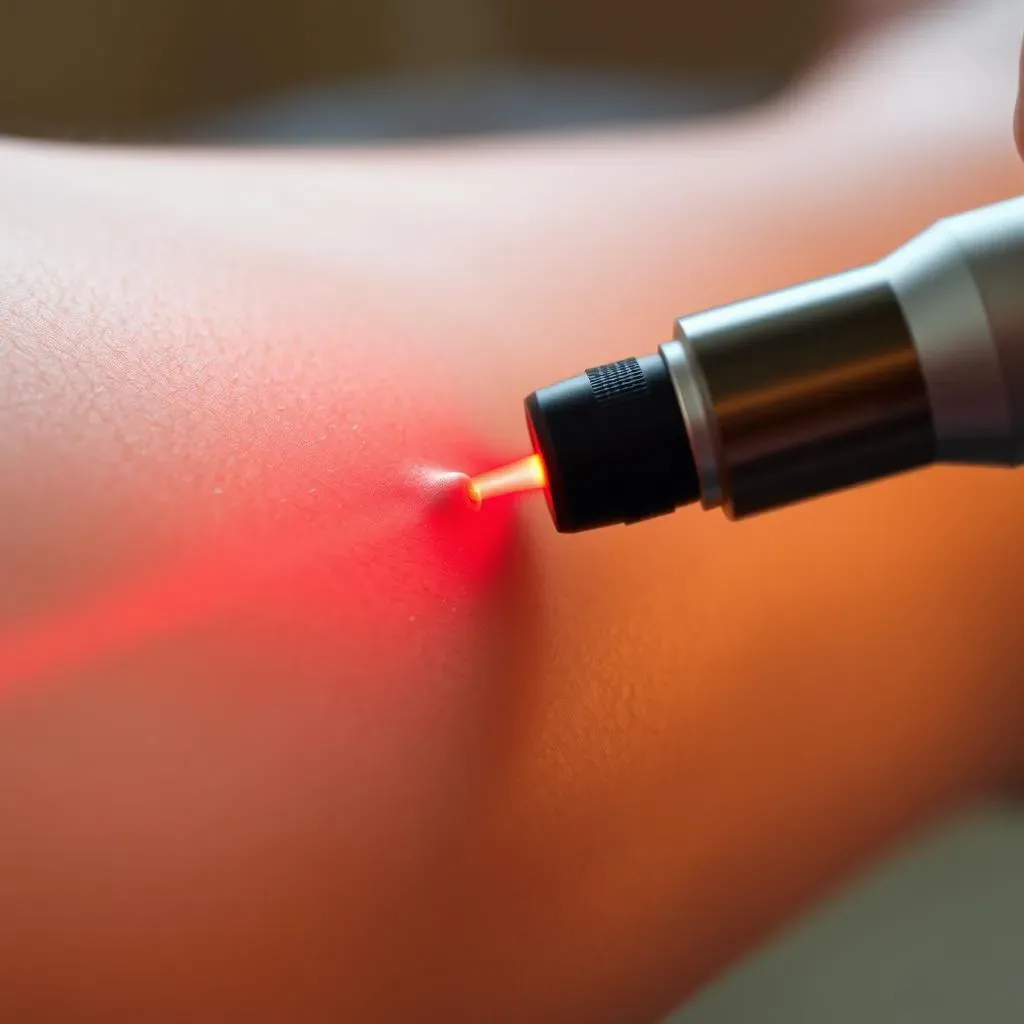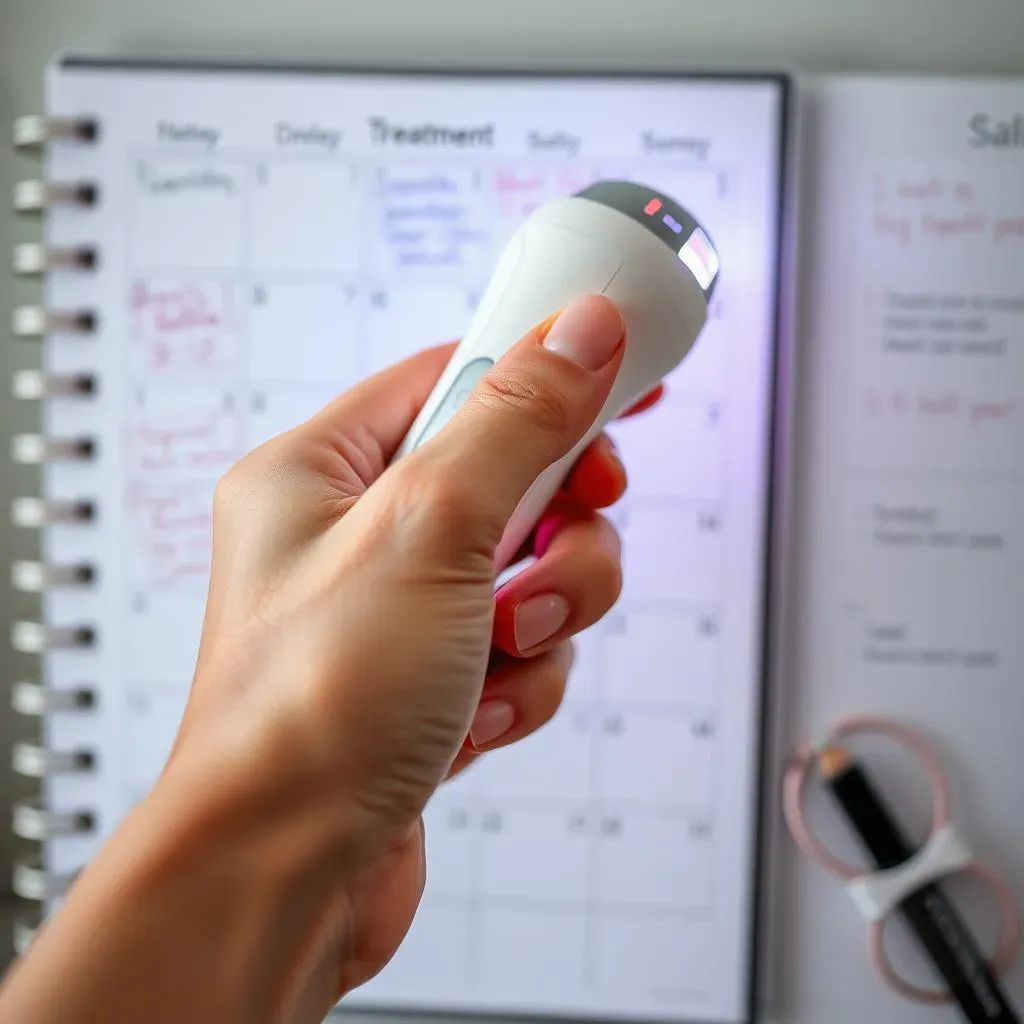Table of Contents
Are you considering at-home laser hair removal but unsure how often to use the device? You're not alone. Many people struggle to determine the ideal treatment schedule for achieving optimal results. Laser hair removal at home can be an effective way to reduce unwanted hair, but it requires a consistent and well-planned approach. The key to success lies in understanding the hair growth cycle and targeting the anagen phase, when hair is most susceptible to laser treatment. But how often should you laser hair removal at home to catch hair in this phase? The answer is not as simple as treating every day. In fact, over-treating can be counterproductive and waste precious laser pulses. In this article, we'll explore the recommended frequency for at-home laser hair removal, how the process works, and provide valuable tips to maximize your results. By the end of this guide, you'll be equipped with the knowledge to create a personalized treatment plan and say goodbye to unwanted hair for good. So, let's dive in and discover how often to laser hair removal at home for the best possible outcomes.
Understanding the Anagen Phase: How Often to Laser Hair Removal at Home

Understanding the Anagen Phase: How Often to Laser Hair Removal at Home
The anagen phase is a critical factor in determining how often to laser hair removal at home. It's the active growth phase of hair, during which the hair follicle is most susceptible to laser treatment. Only about 20% of body hair is in the anagen phase at any given time, which means that multiple treatments are necessary to target all hair follicles.
To effectively reduce hair growth, it's essential to treat the anagen phase. But how can you determine when hair is in this phase? The answer lies in the hair growth cycle, which consists of three phases: anagen, catagen, and telogen. Understanding these phases is crucial for maximizing the effectiveness of at-home laser hair removal.
Hair Growth Phase | Description | Duration |
|---|---|---|
Anagen | Active growth phase | 2-6 years |
Catagen | Transitional phase | 2-3 weeks |
Telogen | Resting phase | 3-4 months |
Given that only 20% of hair is in the anagen phase, it's necessary to space out treatments to catch all hair follicles in this phase. Treating too frequently, such as daily, will not speed up results and may waste laser pulses. Instead, it's recommended to treat every two weeks for the first few months, allowing you to target hair in the anagen phase.
- Treat every 2 weeks for the first 3-4 months
- After initial treatments, switch to monthly touch-ups
- Be consistent with your treatment schedule
By understanding the anagen phase and following a structured treatment schedule, you can achieve optimal results from at-home laser hair removal. Remember, patience is key, as it may take 3-6 months to see significant hair reduction.
Recommended Treatment Schedule for AtHome Laser Hair Removal

Recommended Treatment Schedule for AtHome Laser Hair Removal
Creating a Treatment Plan
Developing a treatment schedule is crucial for achieving optimal results from at-home laser hair removal. The goal is to treat the hair when it's in the anagen phase, which is the active growth phase. Since only 20% of hairs are in this phase at any given time, it's essential to space out treatments to catch all hairs.
A recommended treatment schedule is to use the laser every two weeks for the first three to four months. This allows you to target hair in the anagen phase, maximizing the effectiveness of each treatment. After the initial period, you can switch to monthly touch-ups to maintain the results.
Treatment Phase | Frequency | Duration |
|---|---|---|
Initial Treatments | Every 2 weeks | 3-4 months |
Maintenance | Monthly | Ongoing |
- Treat every 2 weeks for the first 3-4 months
- Switch to monthly treatments after the initial phase
- Be consistent with your treatment schedule
Tracking Progress and Adjusting the Schedule
It's essential to track your progress and adjust your treatment schedule as needed. You may find that certain areas respond faster than others, so you can adjust the frequency accordingly. For example, if you notice that hair growth is slowing down in a particular area, you can reduce the treatment frequency.
Marking your calendar can help you keep track of your treatment days and ensure consistency. It's also crucial to maintain your device properly, such as charging it every three months, to extend its lifespan.
Area | Initial Treatment Frequency | Maintenance Frequency |
|---|---|---|
Face | Every 2 weeks | Every 4-6 weeks |
Body | Every 2 weeks | Every 6-8 weeks |
- Track your progress and adjust the schedule as needed
- Mark your calendar to stay on track
- Maintain your device to ensure optimal performance
How Laser Hair Removal Works and Why Frequency Matters

How Laser Hair Removal Works and Why Frequency Matters
The Science Behind Laser Hair Removal
Laser hair removal works by targeting the pigment in the hair follicle with a beam of light. The light is absorbed by the pigment, causing the follicle to heat up and eventually leading to damage, which inhibits hair growth. However, for the treatment to be effective, the hair must be in the anagen phase, as mentioned earlier.
The frequency of treatments is crucial because laser hair removal is most effective when the hair is in the active growth phase. Treating too frequently can be unnecessary, as the hair may not have entered the anagen phase yet. On the other hand, treating too infrequently may allow the hair to grow back, reducing the overall effectiveness of the treatment.
Phase | Description | Duration |
|---|---|---|
Anagen | Active growth phase | 2-6 years |
Catagen | Transitional phase | 2-3 weeks |
Telogen | Resting phase | 3-4 months |
- The anagen phase is the only phase where hair is susceptible to laser treatment
- Treating too frequently can waste laser pulses
- Treating too infrequently may allow hair to grow back
Why Frequency Matters
The frequency of laser hair removal treatments is critical to achieving optimal results. Since only 20% of hairs are in the anagen phase at any given time, it's essential to space out treatments to catch all hairs in this phase. Treating every two weeks allows you to target hair in the anagen phase, maximizing the effectiveness of each treatment.
It's also important to note that consistent treatment is key. Missing treatments can lead to reduced effectiveness, as hair follicles that were not treated during the anagen phase may enter the catagen or telogen phase, making them resistant to laser treatment.
Treatment Frequency | Duration | Results |
|---|---|---|
Every 2 weeks | 3-4 months | Significant hair reduction |
Monthly | 6-12 months | Maintenance and touch-ups |
- Treat every 2 weeks for the first 3-4 months
- Switch to monthly treatments after the initial phase
- Consistency is key to achieving optimal results
Tips for Effective AtHome Laser Hair Removal Treatments

Tips for Effective AtHome Laser Hair Removal Treatments
Preparing Your Skin for Treatment
Before starting your at-home laser hair removal journey, it's essential to prepare your skin for the treatment. This includes avoiding waxing, tweezing, and depilatory creams for at least two weeks prior to treatment. These methods can cause inflammation and interfere with the laser's ability to target the hair follicle.
Additionally, it's crucial to shave the area to be treated the night before or the morning of the treatment. This helps the laser penetrate the skin more effectively and reduces the risk of burns or injuries. Exfoliating the skin 2-3 days before treatment can also help remove dead skin cells and improve the laser's ability to target the hair follicle.
Pre-Treatment Preparation | Description | Timing |
|---|---|---|
Avoid waxing, tweezing, and depilatory creams | Prevents inflammation and interference with laser treatment | At least 2 weeks before treatment |
Shave the treatment area | Allows laser to penetrate skin more effectively | Night before or morning of treatment |
Exfoliate the skin | Removes dead skin cells and improves laser effectiveness | 2-3 days before treatment |
- Avoid waxing, tweezing, and depilatory creams for 2 weeks before treatment
- Shave the area to be treated the night before or morning of treatment
- Exfoliate the skin 2-3 days before treatment
Optimizing Treatment Settings and Technique
Once you've prepared your skin, it's time to optimize your treatment settings and technique. Start by selecting the right intensity level for your skin tone and hair type. It's essential to begin with a lower intensity and gradually increase as needed to avoid discomfort or skin irritation.
When administering the treatment, hold the device at a 90-degree angle to the skin and move it slowly and steadily over the treatment area. Overlapping pulses can lead to inconsistent results, so it's crucial to maintain a steady pace. Additionally, using the device in a grid pattern can help ensure thorough coverage and prevent missed spots.
- Start with a lower intensity and increase as needed
- Hold the device at a 90-degree angle to the skin
- Move the device slowly and steadily over the treatment area
Maximizing Results: How Often to Laser Hair Removal at Home for LongTerm Reduction

Maximizing Results: How Often to Laser Hair Removal at Home for LongTerm Reduction
Understanding the Importance of Consistency
Consistency is key when it comes to at-home laser hair removal. To maximize results, it's essential to stick to your treatment schedule. Missing treatments can lead to reduced effectiveness, as hair follicles that were not treated during the anagen phase may enter the catagen or telogen phase, making them resistant to laser treatment.
By treating every two weeks for the first three to four months, you can target hair in the anagen phase, leading to significant hair reduction. After the initial phase, switching to monthly touch-ups will help maintain the results. Remember, patience is crucial, as it may take 3-6 months to see full results.
Treatment Phase | Frequency | Duration |
|---|---|---|
Initial Treatments | Every 2 weeks | 3-4 months |
Maintenance | Monthly | Ongoing |
- Treat every 2 weeks for the first 3-4 months
- Switch to monthly treatments after the initial phase
- Consistency is key to achieving optimal results
Optimizing Your Treatment Plan
As you progress with your at-home laser hair removal treatments, it's essential to optimize your treatment plan. This includes adjusting the frequency based on your individual hair growth and responding to changes in your skin and hair.
For example, if you notice that hair growth is slowing down in a particular area, you can reduce the treatment frequency. Conversely, if you notice that hair is growing back faster in another area, you may need to increase the frequency. By tailoring your treatment plan to your specific needs, you can maximize the effectiveness of your treatments.
Area | Initial Treatment Frequency | Maintenance Frequency |
|---|---|---|
Face | Every 2 weeks | Every 4-6 weeks |
Body | Every 2 weeks | Every 6-8 weeks |
- Track your progress and adjust the schedule as needed
- Be flexible with your treatment frequency
- Maintain your device to ensure optimal performance
Maximizing Your Results: Conclusion
Consistency and patience are key when it comes to at-home laser hair removal. By understanding the anagen phase and treating every two weeks, you can effectively reduce unwanted hair over time. Remember, it's essential to follow the recommended treatment schedule, conserve laser pulses, and maintain your device properly. With these tips and a commitment to your treatment plan, you'll be on your way to achieving smooth, hair-free skin. Visit hairawaybylaser.com for more information on at-home laser hair removal and start your journey to a hair-free life today. By following the guidelines outlined in this article, you'll be well on your way to determining how often to laser hair removal at home for optimal results.
